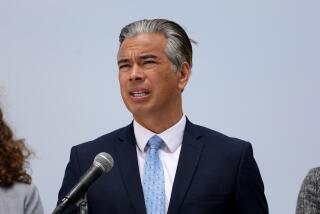Long-Stodgy Texaco Puts on New Face
- Share via
They’re not dropping Bob Hope altogether, Texaco insists. But the octogenarian Texaco spokesman has been shelved in favor of a relentlessly upbeat and high-energy television ad campaign that marks the oil company’s first new advertising initiative in a quarter of a century.
Meanwhile, Texaco’s top management--historically known as a reclusive and insular bunch who would surface grudgingly once a year at the obligatory shareholder meeting--has begun to broadcast its public movements ahead of time and invite reporters and photographers to show up.
“Next week,” a company man confides, “we’re going to announce plans to sponsor mud wrestling.”
He was only joking about the mud wrestling. Even so, one could argue that humor at Texaco is a significant development in itself.
Long an unpopular company within the oil industry, Texaco is earnestly trying to remake itself from top to bottom. Its musty, standoffish ways were thought by some to have invited its disastrous setback at the hands of Pennzoil in November, 1985.
Pennzoil persuaded a Texas jury to award it $10.3 billion on grounds that Texaco wrongly wrested Getty Oil Co. away from it in a 1984 takeover battle. Texaco sought refuge in federal bankruptcy court until settling out of court in December for $3 billion, a payment it is scheduled to make to Pennzoil this week.
Of course, the company has more fundamental problems than a tired advertising jingle and an outdated idea of public relations. For starters, its very survival as Texaco is still uncertain, with corporate raiders positioning themselves for the oil giant’s scheduled emergence from bankruptcy this Thursday.
Rejoining Mainstream
There is also the problem of finding oil. For years, Texaco has done a worse job of it than any major oil firm, seriously diminishing the size of the crude oil reserves that are the lifeblood of any integrated oil company. Critics say this weak performance is the result of decades of managerial inbreeding, an autocratic decision-making style and other elements of a problematic corporate culture.
The company says it is working on all that.
Its oil exploration initiatives, for example, have broadened in the past few years, with positive results. Academic geologists say the aloof Texaco is rejoining the research mainstream. In the same vein, the company’s restructuring plans call for a de-emphasis of the refining and marketing end of the business in favor of exploration and production. It is a reversal of the bias that oil historians say had dominated corporate thinking ever since Texaco helped find oil in Saudi Arabia in the 1930s and then sat on its laurels.
But that sort of change takes decades. A new ad campaign can be implemented by fiat. Even if Texaco hadn’t undergone an almost continual drubbing in the public eye since the Pennzoil courtroom victory, it would certainly have been time for a new ditty.
Gasoline cost 30 cents a gallon when Texaco introduced the theme, “You can trust your car to the man who wears the star,” back in 1962. Stephen Kutler, the company’s new general advertising manager, calls that the most memorable ad jingle in the history of the gasoline business.
It only seems like ages have passed since Texaco enlisted comedian Hope. It was 1974 when he began to deliver variations on the “man who wears the star” theme, sometimes wearing the trademark fireman’s hat that symbolized the old Texaco “fire chief” gasoline. However memorable it once was, in recent years the ad campaign has scarcely registered with the television audience, says David Vadehra of Video Storyboard Tests Inc. in New York.
Every three months, Vadehra rates the top 10 commercials in terms of viewer recall. “Texaco has never, ever come anywhere near it,” he says, adding that it is too soon to measure response to the latest campaign, which first aired in February on the Winter Olympics telecasts.
(Vadehra says the problem with the old ads wasn’t Hope, it was the company. Kutler says Hope remains under contract and Texaco will use him “as we see fit,” probably in its sponsorship of radio broadcasts of the Metropolitan Opera.)
There is little evidence that Texaco’s problems with Pennzoil and subsequent bankruptcy a year ago had any effect on motorists’ gasoline purchasing habits. In Texaco’s research with consumers last year, Kutler says, “It was amazing to us that it didn’t even come up.”
But by the same token, Texaco had become a faceless entity among motorists. While the Amocos and Chevrons were winning consumer-satisfaction polls, “Texaco hasn’t stood out,” according to Dan Larson, editor of Service Station Management magazine in Des Plains, Ill.
The new television ads portray Texaco as a contemporary company with a future. It features regular folks, such as a family driving through a storm at night looking for a gas station while voices sing out, “Up ahead there’s Texaco, star of the American road.” The campaign was created by William Esty Co., Texaco’s ad agency since about the time it lost the $10.3-billion jury verdict to Pennzoil.
Kutler says it was a “fortunate confluence of events” that the ads began running in February, when Texaco had begun its climb out of bankruptcy with an out-of-court settlement and a new reorganization plan. Indeed, he disassociates the new ad campaign from Texaco’s recent troubles, calling it business as usual in light of the change in top management a year ago.
More Accessible
Asked the difference between the old Texaco and the new one heralded by the “star of the American road” ads, Kutler says: “That’s not something I want to get into.”
But others view the ads as an integral part of Texaco’s urgent need for a new public face. Another part is reflected in the company’s sometimes fitful effort to make itself more accessible to the news media and to its own employes, a priority of James W. Kinnear, who became president and chief executive in January, 1987.
“It’s like Vatican II,” gushes K. Peter Maneri, the new manager of media relations.
Maneri said he was hired from Dun & Bradstreet several months ago to help change “the way we deal with the press.” It is an effort that began long before Maneri’s arrival, as Texaco struggled to gain the upper hand in what became a highly visible and bitter war of words with Pennzoil.
Texaco’s new thinking on how to “deal with the press” appears to have gone through several mutations, not to mention changes in personnel. A company unaccustomed to making its executives available for public comment was suddenly foisting them on anyone who would listen.
On other occasions, say reporters who followed the Pennzoil story, there were amateurish attempts at manipulation. The whole issue is understood to have caused considerable disagreement within the company and between Kinnear and Alfred C. DeCrane Jr., the chairman, over how far to go.
“The company is not yet ready to follow that course,” an insider declares.
But Maneri enthusiastically points to such touches as the new message on the company’s little memo pads: “Texaco is ours to build.” He says that reporters “used to camp outside the building. Now we invite them inside.” He says that, during the final bankruptcy court hearing last month, Texaco filed its own dispatches on an internal wire service to keep employees up to date.
“We know that changing the window dressing only goes so far,” he says. “We have to change the substance of the company. But this is stuff that never happened here before. It’s going to sound like just a bunch of P.R., but there is really a whole new generation of leadership.”
More to Read
Sign up for Essential California
The most important California stories and recommendations in your inbox every morning.
You may occasionally receive promotional content from the Los Angeles Times.










